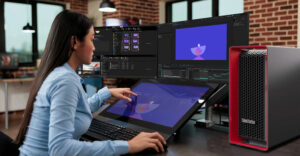
Sun Microsystems showed off new server technology at a press event in New York this week where the firm took the opportunity to tout growth in its server business over consecutive quarters.
As a backdrop to talk about its path to a positive future, Sun announced new Sparc-based Sun Fire workgroup servers and Sun Ultra Workstations that further leverage data center and operational efficiency — features that have helped Sun achieve year-over-year sales and revenue increases.
Its new Sun Fire servers will use the firm’s own UltraSparc IIIi processors and the Solaris 10 operating system.
The firm’s new Ultra 25 Workstation comes equipped with Solaris 10, Sun Studio, Sun Java Studio Creator and Sun Java Studio Enterprise. Sun said the system offers a 300 percent increase in performance.
Sun said its new Sun Fire T1000 system offers up to 300 percent higher performance for disk operations and now features 23 percent higher availability as well.
Attracted to Efficiency
The company also unveiled Netra blade servers equipped with Sun’s popular CoolThreads chips, which can perform 32 processing tasks simultaneously, for telecommunications applications.
Amid continued skepticism over the company’s outlook, Sun hoped to show investors it can widen its gains in the enterprise computing market, which is proving to be receptive to cost and power saving benefits offered by Sun’s “Niagara” UltraSparc T1 chips and CoolThreads energy technology.
The market has been so receptive, in fact, that according to IDC, Sun was recently able to bump Dell from second place behind IBM in overall server sales.
For the most recent quarter, Sun was able to grow its server revenue by more than 15 percent from the last quarter, and in doing so regained a lead over Dell, which had held its number two spot for a few straight quarters, IDC Vice President Jean Bozman told TechNewsWorld.
“Those are both signs that Sun is doing much better now,” Bozman said. “The question is, can they continue it?”
Plotting a Positive Path
The analyst credited Sun for doing “a lot of homework” on the technology, and indicated it is likely a sign of more to come from the firm.
The hardware maker is satisfying its substantial UltraSparc customer base with new features, and working to attract new customers with its Niagara and other newer technologies that work with AMD Opteron processors.
“They have to do well at both,” Bozman said. “That’s what will make this continue.”
Tech Over Talk
Plenty of skepticism has surround the company despite its focus on successful server and Solaris 10 operating system sales, as well as its continued effort to leverage open source software and developers, according to Illuminata Senior Analyst Gordon Haff.
“I think people got used to Sun unveiling some dramatic new strategy or direction, but that’s not where they’re at right now, nor should it be,” he told TechNewsWorld. “They have a lot of strategies that have sort of firmed up in the last year or two, and now it’s really about execution.”
Sun can accurately say it is headed in the right direction, however, the company must transfer its technology advantages to sales dollars to remain there, Haff remarked.
Timing’s Right
While other chip and systems makers have focused on more, “fatter” processor cores, Sun’s approach is to provide many “skinnier” cores, as evidenced by its Niagara T1 chip architecture and technology unveiled last year, according to Haff.
“Among the major systems manufacturers, they have taken the most radical approach to multi-threading,” Haff said.
Sun’s work on achieving power savings with Niagara chips may be paying off, as efficiency is what’s currently in demand among enterprise IT shops, Haff said.
“Call it luck, call it prescience depending on your preferences, but Niagara hit at almost a perfect time,” he noted.





















































